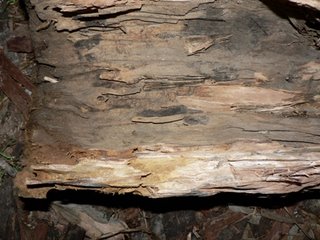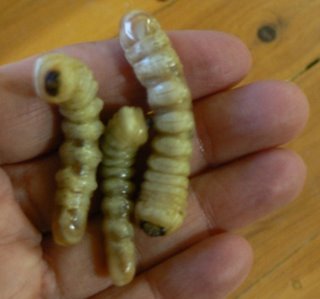
and out tumbled some occupants,

a lively bunch.

Just think if what we ate was as easily seen.
A happy twist in its life for one of the grubs, which was put back on one of the split pieces where it burrowed into the wood again; and if life continues as it should for this witchetty grub, it will end its days as, I think, a hawk moth.

9 comments:
Man, those are huge!
Hey hey! But just think how huge we are to them. I should have specified, Alice. It was a firewood-chopping block, a slice of thickish dead tree that we've used for a chopping block for about ten years. Since the base of it's been damp, it seemed like a good place, I guess, for them to come up from the ground and burrow in to have a feed. They are supposed to be good food, though, tasting like peanut butter, when roasted. Too bad Spencer Pate doesn't live here, as I'm sure he would be able to write a cookbook of recipes for them.
In their stead, and taking into account that you might not live near them, I can recommend another recipe: greens and ants (not fire ants). This recipe, like many of the best, happened by accident on a dark night. The formic acid in the ants gives just the right kick to the dish. Saute quickly with lid on, or your spice will run away.
Anna - I think I actually do have a recipe for Wichetty Grubs in one of my entomophagy books. If I can find it, I'll post it here.
Here is a recipe for wichetty grub dip from Peter Menzel and Faith D’Aluisio’s MAN EATING BUGS. It’s not a cookbook, but rather a fascinating travelogue with lots of gorgeous photos of other cultures and the insect dishes they eat. Every home should have a copy of this book.
Vic Cherikoff’s Wichetty Grub Dip
5 large wichetty grubs
1 teaspoon vegetable oil
1 pinch salt
1 cup low-fat sour cream
½ cup ricotta cheese
Roast or fry grubs in oil until well-browned. Season lightly with salt, then blend to a smooth paste in a food processor with other ingredients. Serve with burrawang bread pieces (burrawang flour has a yeasty cheese flavor and is made from a toxic palm nut after extensive processing) or wattle faltbread (wattle flour is made from the roasted seeds of a type of acacia). (Adapted from UNIQUELY AUSTRALIAN, by Vic Cherikoff).
Well, it can’t be that much stranger than the fried cicadas I’ve eaten…
Spencer,
I must get this book, just what my home needs! I knew it was missing that certain touch. Thanks so much for your contributions. I'll have to make this now, and report, as soon as I can find low-fat witchetty grubs.
And as for that burrawang bread. Hmm. I'll post photos the next time they fruit. These need EXTENSIVE treatment though they look like delicious, flame-orange food for giants.
I probably shouldn't be surprised that you grow the palm nuts used to make burrawang bread! I'm kind of curious to learn how they grow and are processed, so keep us updated.
I don't grow them, Spencer. They grow wild around here.
Dear Anna
These are not witchety grubs per se but the larvae of longicorn beetles (Cerambycidae). The true witcheti grubs are those of the large moths Xyleutes etc which the aboriginals dug out of the roots of wattles (Acacia) in the deserts of central Australia
But of course you can call these witchetti grubs if you like!
Best, Dr Trevor J. Hawkeswood
Thank you for the correction, Dr T! I never knew the term was so specific. Were these larvae a menu item, too, with a different name?
Post a Comment